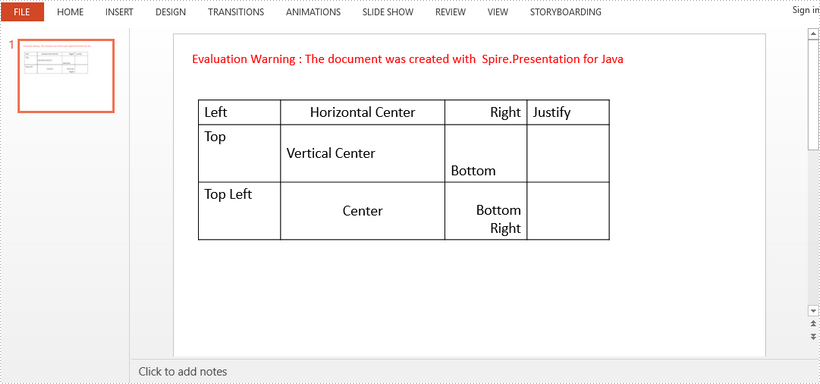Java: Add Hyperlinks to Word Documents
A hyperlink is the most important element that we use in digital documents to make connections between two things. When readers click on a hyperlink in a Word document, it will take them to a different location within the document, to a different file or website, or to a new email message. This article introduces how to add hyperlinks to Word documents in Java using Spire.Doc for Java.
Install Spire.Doc for Java
First, you're required to add the Spire.Doc.jar file as a dependency in your Java program. The JAR file can be downloaded from this link. If you use Maven, you can easily import the JAR file in your application by adding the following code to your project's pom.xml file.
<repositories>
<repository>
<id>com.e-iceblue</id>
<name>e-iceblue</name>
<url>https://repo.e-iceblue.com/nexus/content/groups/public/</url>
</repository>
</repositories>
<dependencies>
<dependency>
<groupId>e-iceblue</groupId>
<artifactId>spire.doc</artifactId>
<version>12.4.6</version>
</dependency>
</dependencies>
Insert Hyperlinks When Adding Paragraphs to Word
Spire.Doc for Java offers the Paragraph.appendHyperlink() method to add a web link, an email link, a file link, or a bookmark link to a piece of text or an image inside a paragraph. The following are the detailed steps.
- Create a Document object.
- Add a section and a paragraph to it.
- Insert a hyperlink based on text using Paragraph.appendHyerplink(String link, String text, HyperlinkType type) method.
- Add an image to the paragraph using Paragraph.appendPicture() method.
- Add a hyperlink to the image using Paragraph.appendHyerplink(String link, DocPicture picture, HyperlinkType type) method.
- Save the document using Document.saveToFile() method.
- Java
import com.spire.doc.BookmarkStart;
import com.spire.doc.Document;
import com.spire.doc.FileFormat;
import com.spire.doc.Section;
import com.spire.doc.documents.BreakType;
import com.spire.doc.documents.HyperlinkType;
import com.spire.doc.documents.Paragraph;
import com.spire.doc.fields.DocPicture;
public class InsertHyperlinks {
public static void main(String[] args) {
//Create a Word document
Document doc = new Document();
//Add a section
Section section = doc.addSection();
//Add a paragraph
Paragraph paragraph = section.addParagraph();
paragraph.appendHyperlink("https://www-iceblue.com/", "Home Page", HyperlinkType.Web_Link);
//Append line breaks
paragraph.appendBreak(BreakType.Line_Break);
paragraph.appendBreak(BreakType.Line_Break);
//Add an email link
paragraph.appendHyperlink("mailto:support@e-iceblue.com", "Mail Us", HyperlinkType.E_Mail_Link);
//Append line breaks
paragraph.appendBreak(BreakType.Line_Break);
paragraph.appendBreak(BreakType.Line_Break);
//Add a file link
String filePath = "C:\\Users\\Administrator\\Desktop\\report.xlsx";
paragraph.appendHyperlink(filePath, "Click to open the report", HyperlinkType.File_Link);
//Append line breaks
paragraph.appendBreak(BreakType.Line_Break);
paragraph.appendBreak(BreakType.Line_Break);
//Add another section and create a bookmark
Section section2 = doc.addSection();
Paragraph bookmarkParagraph = section2.addParagraph();
bookmarkParagraph.appendText("Here is a bookmark");
BookmarkStart start = bookmarkParagraph.appendBookmarkStart("myBookmark");
bookmarkParagraph.getItems().insert(0, start);
bookmarkParagraph.appendBookmarkEnd("myBookmark");
//Link to the bookmark
paragraph.appendHyperlink("myBookmark", "Jump to a location inside this document", HyperlinkType.Bookmark);
//Append line breaks
paragraph.appendBreak(BreakType.Line_Break);
paragraph.appendBreak(BreakType.Line_Break);
//Add an image link
String imagePath = "C:\\Users\\Administrator\\Desktop\\logo.png";
DocPicture picture = paragraph.appendPicture(imagePath);
paragraph.appendHyperlink("https://www.e-iceblue.com/", picture, HyperlinkType.Web_Link);
//Save to file
doc.saveToFile("output/InsertHyperlinks.docx", FileFormat.Docx_2013);
}
}

Add Hyperlinks to Existing Text in Word
Adding hyperlinks to existing text in a document is a bit more complicated. You need to find the target string first, and then replace it in the paragraph with a hyperlink field. The following are the steps.
- Create a Document object.
- Load a Word file using Document.loadFromFile() method.
- Find all the occurrences of the target string in the document using Document.findAllString() method, and get the specific one by its index from the collection.
- Get the string’s own paragraph and its position in it.
- Remove the string from the paragraph.
- Create a hyperlink field and insert it to position where the string is located.
- Save the document to another file using Document.saveToFle() method.
- Java
import com.spire.doc.Document;
import com.spire.doc.FieldType;
import com.spire.doc.FileFormat;
import com.spire.doc.Hyperlink;
import com.spire.doc.documents.*;
import com.spire.doc.fields.Field;
import com.spire.doc.fields.FieldMark;
import com.spire.doc.fields.TextRange;
import com.spire.doc.interfaces.IParagraphBase;
import com.spire.doc.interfaces.ITextRange;
import java.awt.*;
public class AddHyperlinksToExistingText {
public static void main(String[] args) {
//Create a Document object
Document document = new Document();
//Load a Word file
document.loadFromFile("C:\\Users\\Administrator\\Desktop\\sample.docx");
//Find all the occurrences of the string "Java" in the document
TextSelection[] selections = document.findAllString("Java", true, true);
//Get the second occurrence
TextRange range = selections[1].getAsOneRange();
//Get its owner paragraph
Paragraph paragraph = range.getOwnerParagraph();
//Get its position in the paragraph
int index = paragraph.getItems().indexOf(range);
//Remove it from the paragraph
paragraph.getItems().remove(range);
//Create a hyperlink field
Field field = new Field(document);
field.setType(FieldType.Field_Hyperlink);
Hyperlink hyperlink = new Hyperlink(field);
hyperlink.setType(HyperlinkType.Web_Link);
hyperlink.setUri("https:\\en.wikipedia.org\\wiki\\Java_(programming_language)");
paragraph.getItems().insert(index, field);
//Insert a field mark "start" to the paragraph
IParagraphBase item = document.createParagraphItem(ParagraphItemType.Field_Mark);
FieldMark start = (FieldMark)item;
start.setType(FieldMarkType.Field_Separator);
paragraph.getItems().insert(index + 1, start);
//Insert a text range between two field marks
ITextRange textRange = new TextRange(document);
textRange.setText("Java");
textRange.getCharacterFormat().setFontName(range.getCharacterFormat().getFontName());
textRange.getCharacterFormat().setFontSize(range.getCharacterFormat().getFontSize());
textRange.getCharacterFormat().setBold(range.getCharacterFormat().getBold());
textRange.getCharacterFormat().setTextColor(Color.blue);
textRange.getCharacterFormat().setUnderlineStyle(UnderlineStyle.Single);
paragraph.getItems().insert(index + 2, textRange);
//Insert a field mark "end" to the paragraph
IParagraphBase item2 = document.createParagraphItem(ParagraphItemType.Field_Mark);
FieldMark end = (FieldMark)item2;
end.setType(FieldMarkType.Field_End);
paragraph.getItems().insert(index + 3, end);
//Save to file
document.saveToFile("output/AddHyperlink.docx", FileFormat.Docx_2013);
}
}
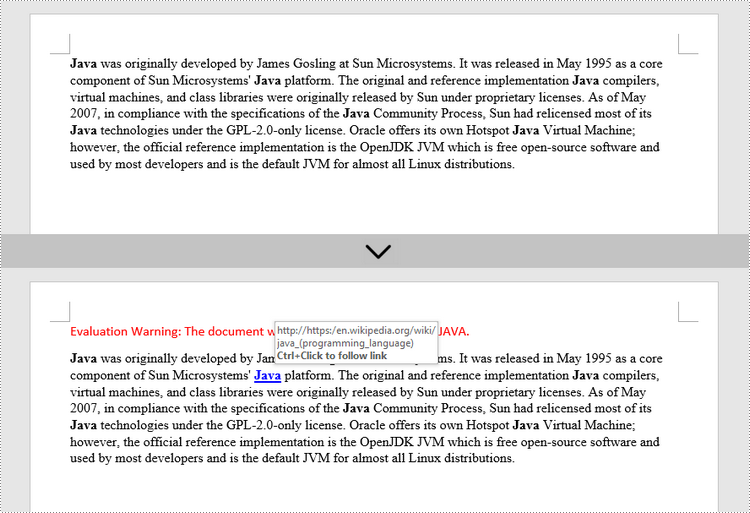
Apply for a Temporary License
If you'd like to remove the evaluation message from the generated documents, or to get rid of the function limitations, please request a 30-day trial license for yourself.
Java: Rotate Pages in PDF
Some scanned PDF documents may contain pages displayed in the wrong orientation (e.g., upside-down), which could cause great inconvenience while reading. Rotating pages can help you solve this problem and provide readers with a better reading experience. This article will introduce how to rotate pages in PDF in Java using Spire.PDF for Java.
Install Spire.PDF for Java
First, you're required to add the Spire.Pdf.jar file as a dependency in your Java program. The JAR file can be downloaded from this link. If you use Maven, you can easily import the JAR file in your application by adding the following code to your project's pom.xml file.
<repositories>
<repository>
<id>com.e-iceblue</id>
<name>e-iceblue</name>
<url>https://repo.e-iceblue.com/nexus/content/groups/public/</url>
</repository>
</repositories>
<dependencies>
<dependency>
<groupId>e-iceblue</groupId>
<artifactId>spire.pdf</artifactId>
<version>10.4.4</version>
</dependency>
</dependencies>
Rotate a Specific Page in PDF in Java
Rotation is based on 90-degree increments. You can rotate a PDF page by 0/90/180/270 degrees. The following are the steps to rotate a PDF page:
- Create an instance of PdfDocument class.
- Load a PDF document using PdfDocument.loadFromFile() method.
- Get the desired page by its index (zero-based) using PdfDocument.getPages().get(pageIndex) method.
- Get the original rotation angle of the page using PdfPageBase.getRotation().getValue() method.
- Increase the original rotation angle by desired degrees.
- Apply the new rotation angle to the page using PdfPageBase.setRotation() method.
- Save the result document using PdfDocument.saveToFile() method.
- Java
import com.spire.pdf.PdfDocument;
import com.spire.pdf.PdfPageBase;
import com.spire.pdf.PdfPageRotateAngle;
public class RotatePdfPage {
public static void main(String []args){
//Create a PdfDocument instance
PdfDocument pdf = new PdfDocument();
//Load a PDF document
pdf.loadFromFile("Sample.pdf");
//Get the first page
PdfPageBase page = pdf.getPages().get(0);
//Get the original rotation angle of the page
int rotation = page.getRotation().getValue();
//Rotate the page 180 degrees clockwise based on the original rotation angle
rotation += PdfPageRotateAngle.Rotate_Angle_180.getValue();
page.setRotation(PdfPageRotateAngle.fromValue(rotation));
//Save the result document
pdf.saveToFile("Rotate.pdf");
}
}

Rotate All Pages in PDF in Java
The following are the steps to rotate all pages in a PDF document:
- Create an instance of PdfDocument class.
- Load a PDF document using PdfDocument.loadFromFile() method.
- Loop through the pages in the document.
- Get the original rotation angle of each page using PdfPageBase.getRotation().getValue() method.
- Increase the original rotation angle by desired degrees.
- Apply the new rotation angle to the page using PdfPageBase.setRotation() method.
- Save the result document using PdfDocument.saveToFile() method.
- Java
import com.spire.pdf.PdfDocument;
import com.spire.pdf.PdfPageBase;
import com.spire.pdf.PdfPageRotateAngle;
public class RotateAllPdfPages {
public static void main(String []args){
//Create a PdfDocument instance
PdfDocument pdf = new PdfDocument();
//Load a PDF document
pdf.loadFromFile("Sample.pdf");
//Loop through each page in the document
for(PdfPageBase page :(Iterable) pdf.getPages()) {
//Get the original rotation angle of the page
int rotation = page.getRotation().getValue();
//Rotate the page 180 degrees clockwise based on the original rotation angle
rotation += PdfPageRotateAngle.Rotate_Angle_180.getValue();
page.setRotation(PdfPageRotateAngle.fromValue(rotation));
}
//Save the result document
pdf.saveToFile("RotateAll.pdf");
}
}
Apply for a Temporary License
If you'd like to remove the evaluation message from the generated documents, or to get rid of the function limitations, please request a 30-day trial license for yourself.
Java: Add, Change or Delete Comments in PowerPoint
When you are collaborating on a PowerPoint document with your team members, adding comments is the most effective way to give feedbacks or communicate the changes you need to make on a particular slide. Once a comment has been added, you may also need to edit or delete it later. This article will demonstrate how to programmatically add, change or delete comments in a PowerPoint Document using Spire.Presentation for Java.
- Add a Comment to a Presentation Slide in Java
- Change a Comment in a Presentation Slide in Java
- Delete a Comment from a Presentation Slide in Java
Install Spire.Presentation for Java
First of all, you're required to add the Spire.Presentation.jar file as a dependency in your Java program. The JAR file can be downloaded from this link. If you use Maven, you can easily import the JAR file in your application by adding the following code to your project's pom.xml file.
<repositories>
<repository>
<id>com.e-iceblue</id>
<name>e-iceblue</name>
<url>https://repo.e-iceblue.com/nexus/content/groups/public/</url>
</repository>
</repositories>
<dependencies>
<dependency>
<groupId>e-iceblue</groupId>
<artifactId>spire.presentation</artifactId>
<version>9.4.5</version>
</dependency>
</dependencies>
Add a Comment to a Presentation Slide in Java
Spire.Presentation for Java offers the ISlide.addComment() method to add comments to a specified PowerPoint slide. The following are the steps to add a PowerPoint comment.
- Initialize an instance of Presentation class.
- Load a PowerPoint document using Presentation.loadFromFile() method.
- Add the author of the comment using Presentation.getCommentAuthors().addAuthor() method.
- Get a specified slide using Presentation.getSlides().get() method, and then add a comment to the slide using ISlide.addComment(ICommentAuthor author, java.lang.String text, java.awt.geom.Point2D position, java.util.Date dateTime) method.
- Save the result document using Presentation.saveToFile() method.
- Java
import com.spire.presentation.*;
import java.awt.geom.Point2D;
public class AddComment {
public static void main(String[] args) throws Exception{
//Initialize an instance of Presentation class
Presentation ppt = new Presentation();
//Load a sample PowerPoint document
ppt.loadFromFile("C:\\Users\\Administrator\\Desktop\\Sample.pptx");
//Add the author of the comment
ICommentAuthor author = ppt.getCommentAuthors().addAuthor("E-iceblue", "Comment:");
//Add a comment to the specified slide
ppt.getSlides().get(0).addComment(author, "The first comment", new Point2D.Float(350, 170), new java.util.Date());
//Save the result document
ppt.saveToFile("AddComment.pptx", FileFormat.PPTX_2013);
ppt.dispose();
}
}

Change a Comment in a Presentation Slide in Java
To update or modify the content of an existing comment, you can use the ISlide.getComments().setText() method. The following are the steps to change a PowerPoint comment.
- Initialize an instance of Presentation class.
- Load a PowerPoint document using Presentation.loadFromFile() method.
- Get a specified slide using Presentation.getSlides().get() method.
- Replace a specified comment in the slide using ISlide.getComments().setText() method.
- Save the result document using Presentation.saveToFile() method.
- Java
import com.spire.presentation.*;
public class ReplaceComment {
public static void main(String[] args) throws Exception{
//Initialize an instance of Presentation class
Presentation ppt = new Presentation();
//Load a sample PowerPoint document
ppt.loadFromFile("AddComment.pptx");
//Get the first slide
ISlide slide = ppt.getSlides().get(0);
//Replace a specified comment in the slide
slide.getComments()[0].setText("Summary of Spire.Presentation for Java functions");
//Save the result document
ppt.saveToFile("ReplaceComment.pptx", FileFormat.PPTX_2013);
ppt.dispose();
}
}
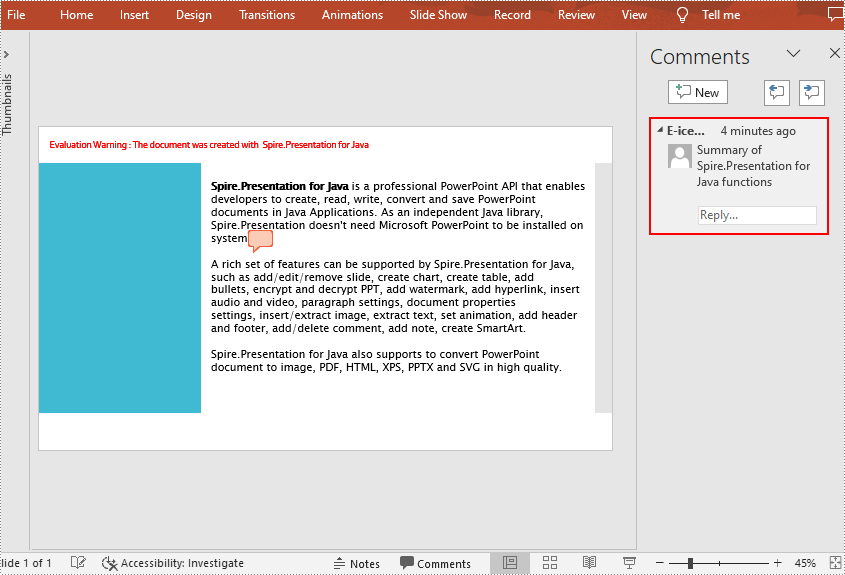
Delete a Comment from a Presentation Slide in Java
Spire.Presentation for Java also allows you to remove comments from a specified slide using ISlide.deleteComment() method. The detailed steps are as follows.
- Initialize an instance of Presentation class.
- Load a PowerPoint document using Presentation.loadFromFile() method.
- Get a specified slide using Presentation.getSlides().get() method.
- Remove a specified comment from the slide using ISlide.deleteComment(Comment comment) method.
- Save the result document using Presentation.saveToFile() method.
- Java
import com.spire.presentation.*;
public class DeleteComment {
public static void main(String[] args) throws Exception{
//Initialize an instance of Presentation class
Presentation ppt = new Presentation();
//Load a sample PowerPoint document
ppt.loadFromFile("AddComment.pptx");
//Get the first slide
ISlide slide = ppt.getSlides().get(0);
//Remove a specified comment from the slide
slide.deleteComment(slide.getComments()[0]);
//Save the result document
ppt.saveToFile("DeleteComment.pptx", FileFormat.PPTX_2013);
ppt.dispose();
}
}
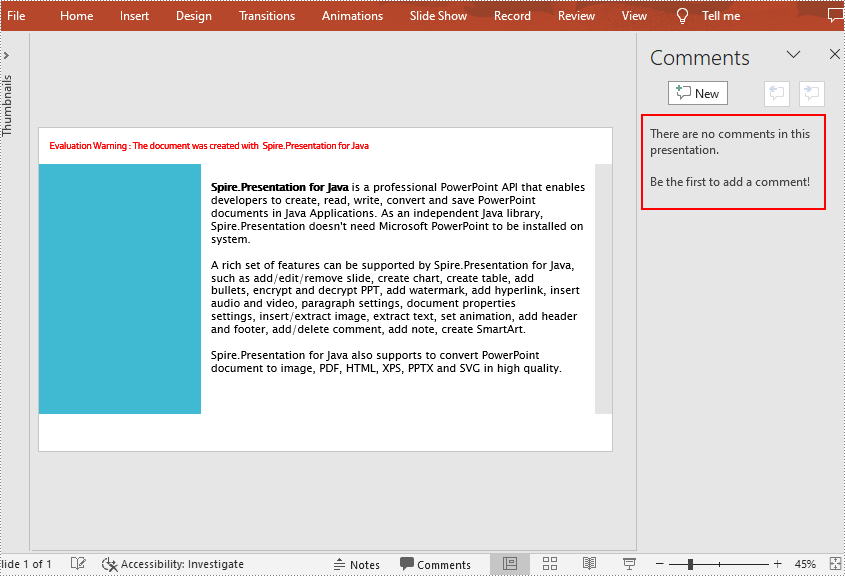
Apply for a Temporary License
If you'd like to remove the evaluation message from the generated documents, or to get rid of the function limitations, please request a 30-day trial license for yourself.
Java: Add, Modify, or Remove Footers in PowerPoint Documents
Adding, modifying, and removing footers in PowerPoint documents is crucial as footers can provide additional information and organizational structure to the document. By including page numbers, dates, author information, or custom text in the footer, it can help the audience better understand the presentation content and track document versions. Footers also enhance the professionalism and tidiness of the document, making it more visually appealing and readable. Modifying footers allows for updating information or adjusting formats as needed to ensure the document remains current and consistent. Removing footers can customize the document's appearance based on specific requirements or design preferences. This article will introduce how to use Spire.Presentation for Java to add, modify, and remove footers in PowerPoint documents within a Java project.
- Java Add Footers in PowerPoint Documents
- Java Modify Footers in PowerPoint Documents
- Java Remove Footers in PowerPoint Documents
Install Spire.Presentation for Java
First of all, you're required to add the Spire.Presentation.jar file as a dependency in your Java program. The JAR file can be downloaded from this link. If you use Maven, you can easily import the JAR file in your application by adding the following code to your project's pom.xml file.
<repositories>
<repository>
<id>com.e-iceblue</id>
<name>e-iceblue</name>
<url>https://repo.e-iceblue.com/nexus/content/groups/public/</url>
</repository>
</repositories>
<dependencies>
<dependency>
<groupId>e-iceblue</groupId>
<artifactId>spire.presentation</artifactId>
<version>9.4.5</version>
</dependency>
</dependencies>
Java Add Footers in PowerPoint Documents
Using Spire.Presentation, you can easily add consistent footer content to the bottom of each page in a PowerPoint document. By adding footer placeholders, page number placeholders, and time placeholders, you can ensure that the footer content on each page remains consistent. Here are the detailed steps:
- Create a lisentation object.
- Load a PowerPoint document using the lisentation.loadFromFile() method.
- Set the footer visible using lisentation.setFooterVisible(true) and set the footer text.
- Set the slide number visible using lisentation.setSlideNumberVisible(true), iterate through each slide, check for the lisence of a page number placeholder, and modify the text to the "Page X" format if found.
- Set the date and time visible using lisentation.setDateTimeVisible(true).
- Set the format of the date using the lisentation.setDateTime() method.
- Save the document to a specified path using the lisentation.saveToFile() method.
- Java
using Spire.Presentation;
namespace SpirePresentationDemo
{
internal class Program
{
static void Main(string[] args)
{
// Create a Presentation object
Presentation presentation = new Presentation();
// Load the presentation from a file
presentation.LoadFromFile("Sample1.pptx");
// Set the footer visible
presentation.FooterVisible = true;
// Set the footer text to "Spire.Presentation"
presentation.SetFooterText("Spire.Presentation");
// Set slide number visible
presentation.SlideNumberVisible = true;
// Iterate through each slide in the presentation
foreach (ISlide slide in presentation.Slides)
{
foreach (IShape shape in slide.Shapes)
{
if (shape.Placeholder != null)
{
// If it is a slide number placeholder
if (shape.Placeholder.Type.Equals(PlaceholderType.SlideNumber))
{
TextParagraph textParagraph = (shape as IAutoShape).TextFrame.TextRange.Paragraph;
String text = textParagraph.Text;
// Modify the slide number text to "Slide X"
textParagraph.Text = "Slide " + text;
}
}
}
}
// Set date time visible
presentation.DateTimeVisible = true;
// Set date time format
presentation.SetDateTime(DateTime.Now, "MM/dd/yyyy");
// Save the modified presentation to a file
presentation.SaveToFile("AddFooter.pptx", FileFormat.Pptx2016);
// Dispose of the Presentation object resources
presentation.Dispose();
}
}
}

Java Modify Footers in PowerPoint Documents
To modify the footer in a PowerPoint document, you need to inspect each shape on every slide to identify footer placeholders, page number placeholders, and so on. By recognizing these placeholders, you can set specific content and formats for each type. Here are the detailed steps:
- Create a Presentation object.
- Load a PowerPoint document using the Presentation.loadFromFile() method.
- Retrieve a slide using the Presentation.getSlides().get(index) method.
- Iterate through the shapes on the slide using a for loop, inspect each shape to determine if it is a placeholder for the footer, page number, etc., and then modify its content or format accordingly.
- Save the document to a specified path using the Presentation.saveToFile() method.
- Java
import com.spire.presentation.*;
import com.spire.presentation.drawing.FillFormatType;
import java.awt.*;
public class ModifyFooter {
public static void main(String[] args) throws Exception {
// Create a Presentation object
Presentation presentation = new Presentation();
// Load a presentation from a file
presentation.loadFromFile("Sample2.pptx");
// Get the first slide
ISlide slide = presentation.getSlides().get(0);
// Iterate through shapes on the slide
for (int i = 0; i < slide.getShapes().getCount(); i++) {
// Check if the shape is a placeholder
if (slide.getShapes().get(i).getPlaceholder() != null) {
// Get the placeholder type
PlaceholderType type = slide.getShapes().get(i).getPlaceholder().getType();
// If it's a footer placeholder
if (type == PlaceholderType.FOOTER) {
// Convert the shape to IAutoShape type
IAutoShape autoShape = (IAutoShape) slide.getShapes().get(i);
// Set the text content to "E-ICEBLUE"
autoShape.getTextFrame().setText("E-ICEBLUE");
// Modify the font of the text
ChangeFont(autoShape.getTextFrame().getParagraphs().get(0));
}
// If it's a slide number placeholder
if (type == PlaceholderType.SLIDE_NUMBER) {
// Convert the shape to IAutoShape type
IAutoShape autoShape = (IAutoShape) slide.getShapes().get(i);
// Modify the font of the text
ChangeFont(autoShape.getTextFrame().getParagraphs().get(0));
}
}
}
// Save the modified presentation to a file
presentation.saveToFile("ModifiedFooter.pptx", FileFormat.PPTX_2016);
// Dispose of the Presentation object resources
presentation.dispose();
}
static void ChangeFont(ParagraphEx paragraph)
{
// Iterate through each text range in the paragraph
for (int i = 0; i < paragraph.getTextRanges().getCount(); i++) {
// Set the text style to italic
paragraph.getTextRanges().get(i).isItalic(TriState.TRUE);
// Set the text font
paragraph.getTextRanges().get(i).setEastAsianFont (new TextFont("Times New Roman"));
// Set the text font size to 34
paragraph.getTextRanges().get(i).setFontHeight(34);
// Set the text color
paragraph.getTextRanges().get(i).getFill().setFillType(FillFormatType.SOLID);
paragraph.getTextRanges().get(i).getFill().getSolidColor().setColor(Color.BLUE);
}
}
}

Java Remove Footers in PowerPoint Documents
To delete the footer in a PowerPoint document, you first need to retrieve content such as footer placeholders, page number placeholders, time placeholders, etc., within the slides. Once these placeholders are identified, you can locate and remove them from the collection of shapes on the slide. Here are the detailed steps:
- Create a Presentation object.
- Load a PowerPoint document using the Presentation.loadFromFile() method.
- Retrieve a slide using the Presentation.getSlides().get(index) method.
- Iterate through the shapes on the slide using a for loop, check if they are placeholders, and if they are footer placeholders, page number placeholders, time placeholders, remove them from the slide.
- Save the document to a specified path using the Presentation.saveToFile() method.
- Java
import com.spire.presentation.*;
public class RemoveFooter {
public static void main(String[] args) throws Exception {
// Create a Presentation object
Presentation presentation = new Presentation();
// Load the presentation from a file
presentation.loadFromFile("Sample2.pptx");
// Get the first slide
ISlide slide = presentation.getSlides().get(0);
// Iterate through the shapes on the slide
for (int i = slide.getShapes().getCount() - 1; i >= 0; i--) {
// Check if the shape is a placeholder
if (slide.getShapes().get(i).getPlaceholder() != null) {
// Get the placeholder type
PlaceholderType type = slide.getShapes().get(i).getPlaceholder().getType();
// If it's a footer placeholder
if (type == PlaceholderType.FOOTER) {
// Remove it from the slide
slide.getShapes().removeAt(i);
}
// If it's a slide number placeholder
if (type == PlaceholderType.SLIDE_NUMBER) {
// Remove it from the slide
slide.getShapes().removeAt(i);
}
// If it's a date and time placeholder
if (type == PlaceholderType.DATE_AND_TIME) {
// Remove it from the slide
slide.getShapes().removeAt(i);
}
}
}
// Save the modified presentation to a file
presentation.saveToFile("RemovedFooter.pptx", FileFormat.PPTX_2016);
// Dispose of the Presentation object resources
presentation.dispose();
}
}
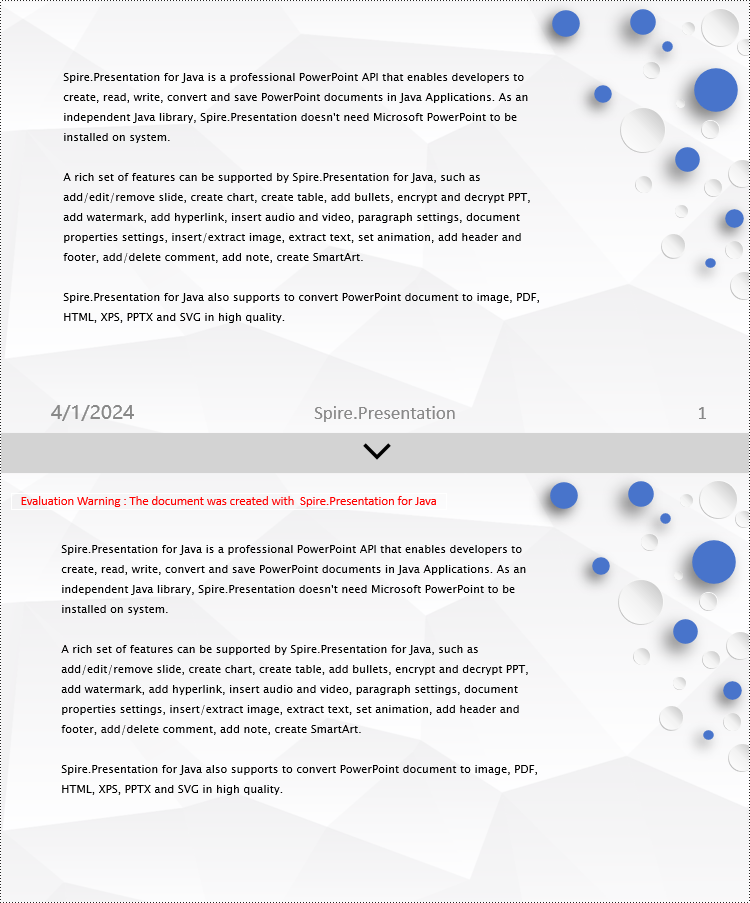
Apply for a Temporary License
If you'd like to remove the evaluation message from the generated documents, or to get rid of the function limitations, please request a 30-day trial license for yourself.
C# add new text strings after the searched text string in word document
With Spire.Doc for .NET, we can easily insert new text to word document at exact position, it also supports to insert new text after the certain text strings at many places. This article will show you how to insert new text strings after the searched text string in word document.
using Spire.Doc;
using Spire.Doc.Documents;
using Spire.Doc.Fields;
using System.Drawing;
namespace Word
{
class Program
{
static void Main(string[] args)
{
//load the sample document
Document doc = new Document();
doc.LoadFromFile("Sample.docx", FileFormat.Docx2010);
//find all the text string “New Zealand” from the sample document
TextSelection[] selections = doc.FindAllString("New Zealand", true, true);
int index = 0;
//defines text range
TextRange range = new TextRange(doc);
//insert new text string (NY) after the searched text string
foreach (TextSelection selection in selections)
{
range = selection.GetAsOneRange();
TextRange newrange = new TextRange(doc);
newrange.Text = ("(NY)");
index = range.OwnerParagraph.ChildObjects.IndexOf(range);
range.OwnerParagraph.ChildObjects.Insert(index + 1, newrange);
}
//find and highlight the newly added text string NY
TextSelection[] text2 = doc.FindAllString("NY", false, true);
foreach (TextSelection seletion in text2)
{
seletion.GetAsOneRange().CharacterFormat.HighlightColor = Color.Yellow;
}
//save the document
doc.SaveToFile("Result.docx", FileFormat.Docx2010);
}
}
}
Effective screenshot after adding the text strings to the searched text:
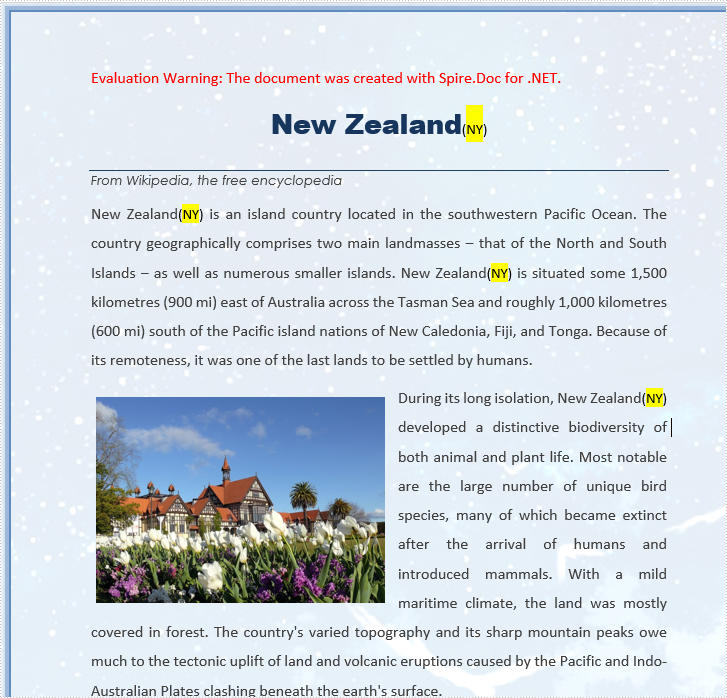
Create a Combination Chart in PowerPoint in Java
A combination chart is a chart that combines at least two chart types in a single chart. This article introduces how to combine clustered column and line chart in PowerPoint using Spire.Presentation for Java.
import com.spire.presentation.FileFormat;
import com.spire.presentation.Presentation;
import com.spire.presentation.charts.ChartType;
import com.spire.presentation.charts.IChart;
import com.spire.presentation.drawing.FillFormatType;
import java.awt.geom.Rectangle2D;
public class CombinationChart {
public static void main(String[] args) throws Exception {
//create a PowerPoint document
Presentation presentation = new Presentation();
//insert a column clustered chart
Rectangle2D.Double rect = new Rectangle2D.Double(50, 100, 550, 300);
IChart chart = presentation.getSlides().get(0).getShapes().appendChart(ChartType.COLUMN_CLUSTERED, rect);
//set chart title
chart.getChartTitle().getTextProperties().setText("Sales vs. Unit Price");
chart.getChartTitle().getTextProperties().isCentered(true);
chart.getChartTitle().setHeight(30);
chart.hasTitle(true);
//write data to chart as chart data
chart.getChartData().get(0,0).setText("Month");
chart.getChartData().get(0,1).setText("Unit Price");
chart.getChartData().get(0,2).setText("Sales");
chart.getChartData().get(1,0).setText("January");
chart.getChartData().get(1,1).setNumberValue(120);
chart.getChartData().get(1,2).setNumberValue(5600);
chart.getChartData().get(2,0).setText("February");
chart.getChartData().get(2,1).setNumberValue(100);
chart.getChartData().get(2,2).setNumberValue(7300);
chart.getChartData().get(3,0).setText("March");
chart.getChartData().get(3,1).setNumberValue(80);
chart.getChartData().get(3,2).setNumberValue(10200);
chart.getChartData().get(4,0).setText("April");
chart.getChartData().get(4,1).setNumberValue(120);
chart.getChartData().get(4,2).setNumberValue(5900);
chart.getChartData().get(5,0).setText("May");
chart.getChartData().get(5,1).setNumberValue(90);
chart.getChartData().get(5,2).setNumberValue(9500);
chart.getChartData().get(6,0).setText("June");
chart.getChartData().get(6,1).setNumberValue(110);
chart.getChartData().get(6,2).setNumberValue(7200);
//set series labels
chart.getSeries().setSeriesLabel(chart.getChartData().get("B1", "C1"));
//set categories labels
chart.getCategories().setCategoryLabels(chart.getChartData().get("A2", "A7"));
//assign data to series values
chart.getSeries().get(0).setValues(chart.getChartData().get("B2", "B7"));
chart.getSeries().get(1).setValues(chart.getChartData().get("C2", "C7"));
//change the chart type of series 2 to line with markers
chart.getSeries().get(1).setType(ChartType.LINE_MARKERS);
//plot data of series 2 on the secondary axis
chart.getSeries().get(1).setUseSecondAxis(true);
//hide grid links of secondary axis
chart.getSecondaryValueAxis().getMajorGridTextLines().setFillType(FillFormatType.NONE);
//set overlap
chart.setOverLap(-50);
//set gap width
chart.setGapDepth(200);
//save the document
presentation.saveToFile("CombinationChart.pptx", FileFormat.PPTX_2010);
}
}
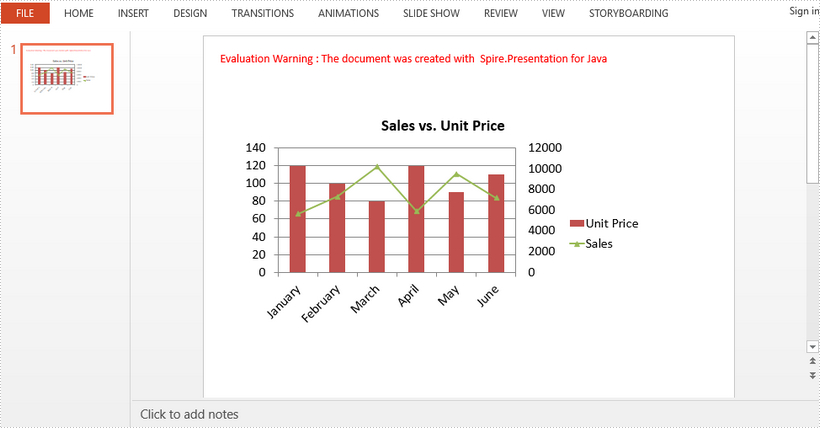
Replace image with new image in PDF in Java
This article demonstrates how to replace an existing image with a new image in a PDF file using Spire.PDF for Java.
Below is the screenshot of the input PDF file we used for demonstration:
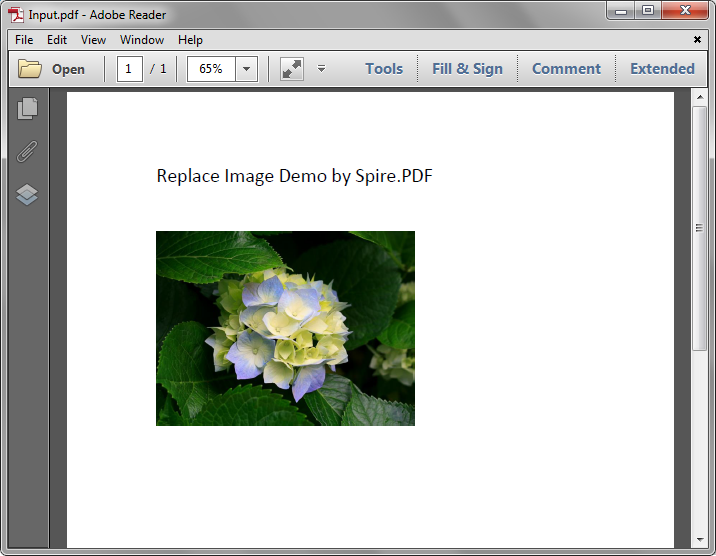
import com.spire.pdf.PdfDocument;
import com.spire.pdf.PdfPageBase;
import com.spire.pdf.graphics.PdfImage;
import java.io.IOException;
public class ReplaceImage {
public static void main(String[] args) throws IOException {
//Load the PDF file
PdfDocument pdf = new PdfDocument();
pdf.loadFromFile("Input.pdf");
//Get the first page
PdfPageBase page = pdf.getPages().get(0);
//Load an image
PdfImage image = PdfImage.fromFile("Image.png");
//Replace the first image in the first page with the loaded image
page.replaceImage(0, image);
//Save the file
pdf.saveToFile("ReplaceImage.pdf");
}
}
Output:

Java: Convert PowerPoint to XPS
XPS (XML Paper Specification) is a fixed-format document described by an XML-based language. It maintains a consistent appearance for documents, which is an ideal file format for publishing, archiving and transmitting. This article will demonstrate how to programmatically convert PowerPoint to XPS using Spire.Presentation for Java.
Install Spire.Presentation for Java
First of all, you're required to add the Spire.Presentation.jar file as a dependency in your Java program. The JAR file can be downloaded from this link. If you use Maven, you can easily import the JAR file in your application by adding the following code to your project's pom.xml file.
<repositories>
<repository>
<id>com.e-iceblue</id>
<name>e-iceblue</name>
<url>https://repo.e-iceblue.com/nexus/content/groups/public/</url>
</repository>
</repositories>
<dependencies>
<dependency>
<groupId>e-iceblue</groupId>
<artifactId>spire.presentation</artifactId>
<version>9.4.5</version>
</dependency>
</dependencies>
Convert PowerPoint to XPS
The detailed steps are as follows:
- Create a Presentation instance.
- Load a sample PowerPoint document using Presentation.loadFromFile() method.
- Save the PowerPoint document to XPS using Presentation.saveToFile(java.lang.String file, FileFormat fileFormat) method.
- Java
import com.spire.presentation.*;
public class PowerPointtoXPS {
public static void main(String[] args) throws Exception{
//Create a Presentation instance
Presentation ppt = new Presentation();
//Load a sample PowerPoint file
ppt.loadFromFile("E:\\Files\\test.pptx");
//Save to XPS file
ppt.saveToFile("toXPS.xps", FileFormat.XPS);
ppt.dispose();
}
}

Apply for a Temporary License
If you'd like to remove the evaluation message from the generated documents, or to get rid of the function limitations, please request a 30-day trial license for yourself.
Get PDF Page Labels in C#
Page labels are used to identify each page visually on the screen or in print. This article demonstrates how to get the PDF page labels using Spire.PDF.
Below is the screenshot of the sample PDF document:
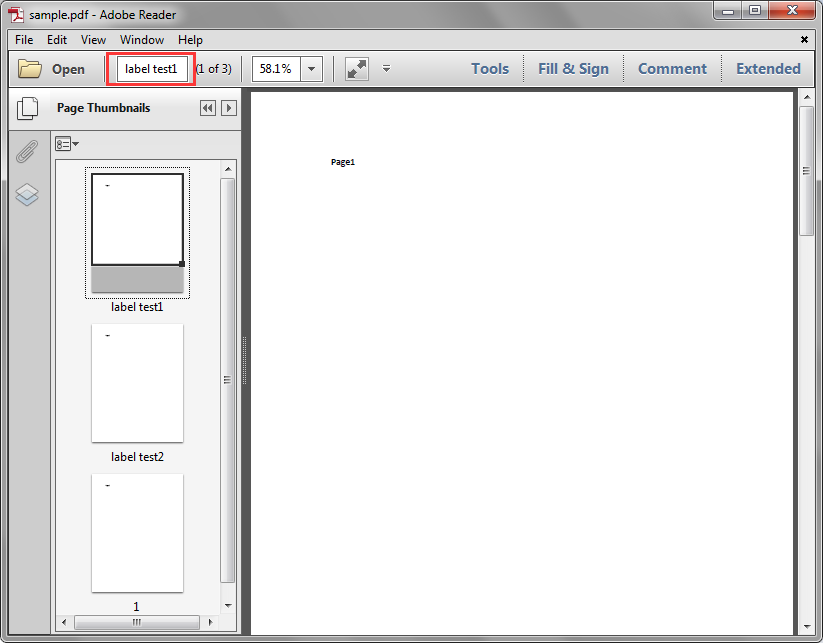
Detail steps:
Step 1: Create a PdfDocument instance and load the sample.pdf file.
PdfDocument pdf = new PdfDocument();
pdf.LoadFromFile("sample.pdf");
Step 2: Get the labels of the pages in the PDF file.
StringBuilder sb = new StringBuilder();
for (int i = 0; i < pdf.Pages.Count; i++)
{
sb.AppendLine(pdf.Pages[i].PageLabel);
}
Step 3: Save to a .txt file.
File.WriteAllText("PageLabels.txt", sb.ToString());
Output:
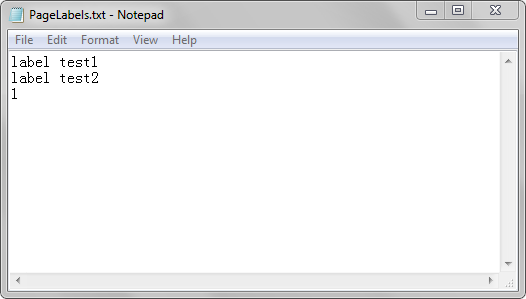
Full code:
using System.IO;
using System.Text;
using Spire.Pdf;
namespace Get_PDF_Page_Labels
{
class Program
{
static void Main(string[] args)
{
//Create a PdfDocument instance
PdfDocument pdf = new PdfDocument();
//Load the PDF file
pdf.LoadFromFile("sample.pdf");
//Create a StringBuilder instance
StringBuilder sb = new StringBuilder();
//Get the lables of the pages in the PDF file
for (int i = 0; i < pdf.Pages.Count; i++)
{
sb.AppendLine(pdf.Pages[i].PageLabel);
}
//Save to a .txt file
File.WriteAllText("PageLabels.txt", sb.ToString());
}
}
}
Align Text in PowerPoint Table in Java
This article demonstrates how to align text within a table cell in PowerPoint using Spire.Presenatation for Java.
Code Snippets
import com.spire.presentation.*;
public class AlignTextInTableCell {
public static void main(String[] args) throws Exception {
//create a PowerPoint file
Presentation presentation = new Presentation();
//add a table
Double[] widths = new Double[]{100d, 200d, 100d, 100d};
Double[] heights = new Double[]{30d, 70d, 70d};
ITable table = presentation.getSlides().get(0).getShapes().appendTable(30,80, widths, heights);
table.setStylePreset(TableStylePreset.NONE);
//set the horizontal alignment for the cells in the first row
table.get(0, 0).getTextFrame().setText("Left");
table.get(0, 0).getTextFrame().getParagraphs().get(0).setAlignment(TextAlignmentType.LEFT);
table.get(1, 0).getTextFrame().setText("Horizontal Center");
table.get(1, 0).getTextFrame().getParagraphs().get(0).setAlignment(TextAlignmentType.CENTER);
table.get(2, 0).getTextFrame().setText("Right");
table.get(2, 0).getTextFrame().getParagraphs().get(0).setAlignment(TextAlignmentType.RIGHT);
table.get(3, 0).getTextFrame().setText("Justify");
table.get(3, 0).getTextFrame().getParagraphs().get(0).setAlignment(TextAlignmentType.JUSTIFY);
//Set the vertical alignment for the cells in the second row
table.get(0, 1).getTextFrame().setText("Top");
table.get(0, 1).setTextAnchorType(TextAnchorType.TOP);
table.get(1, 1).getTextFrame().setText("Vertical Center");
table.get(1, 1).setTextAnchorType(TextAnchorType.CENTER);
table.get(2, 1).getTextFrame().setText("Bottom");
table.get(2, 1).setTextAnchorType(TextAnchorType.BOTTOM);
//set the both horizontal and vertical alignment for the cells in the third row
table.get(0, 2).getTextFrame().setText("Top Left");
table.get(0, 2).getTextFrame().getParagraphs().get(0).setAlignment(TextAlignmentType.LEFT);
table.get(0, 2).setTextAnchorType(TextAnchorType.TOP);
table.get(1, 2).getTextFrame().setText("Center");
table.get(1, 2).getTextFrame().getParagraphs().get(0).setAlignment(TextAlignmentType.CENTER);
table.get(1, 2).setTextAnchorType(TextAnchorType.CENTER);
table.get(2, 2).getTextFrame().setText("Bottom Right");
table.get(2, 2).getTextFrame().getParagraphs().get(0).setAlignment(TextAlignmentType.RIGHT);
table.get(2, 2).setTextAnchorType(TextAnchorType.BOTTOM);
//save to file
presentation.saveToFile("output/Alignment.pptx", FileFormat.PPTX_2013);
presentation.dispose();
}
}
Output
